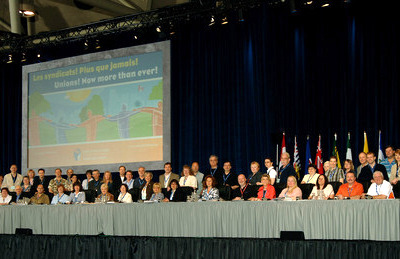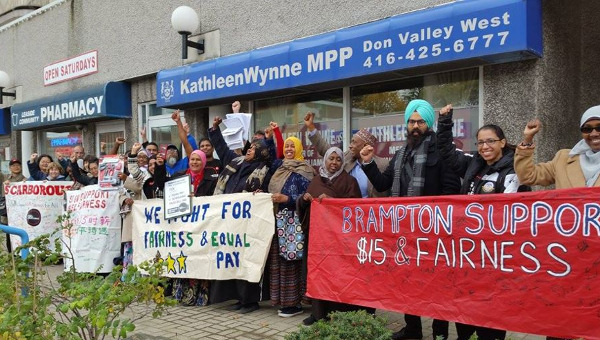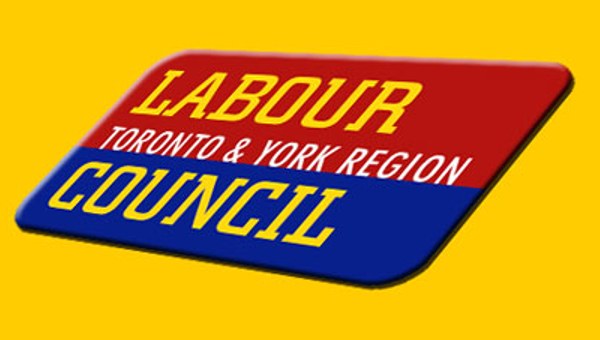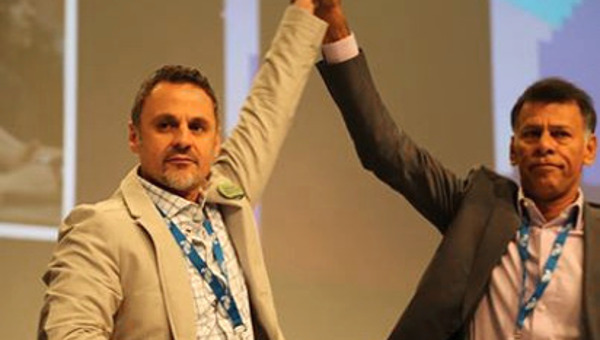CLC Convention Highlights the Challenges Facing the Labour Movement in Canada
The triennial convention of the Canadian Labour Congress held in Toronto from May 26 to 30 revealed the positive changes that have edged their way into the labour movement in recent years. It also showed the weighty obstacles that stand in the way of the organization’s transformation into a more militant, fighting force on behalf of the working class.
On the positive side, a number of resolutions reflected the social rights work and spirit of solidarity on important issues by Congress affiliates, union activists and social movements that overlap with the labour movement. Chief among these was a resolution opposing Canada’s participation in the imperialist war of aggression in Afghanistan. It was adopted by a large majority of delegates and it calls for an end to that war and the immediate withdrawal of Canadian soldiers. (The resolution and the debate surrounding it can be read on this author’s blogsite).

Notwithstanding feeble policy resolutions (more on this later), the convention devoted a lot of time to discussion on the urgent climate change crisis and to the harsh social and economic conditions facing Indigenous peoples in Canada. It examined the unique challenges facing unions as the number of part-time and “temporary” jobs grows, while hundreds of thousands of “temporary” workers from other countries, allowed into Canada to work in low-paid jobs, are deprived of legal citizenship rights, including the right to join trade unions. The convention was marked by frank debate on these issues.
Other examples of progressive resolutions and sympathies among the 1,700 delegates and dozens of affiliates of the Congress gathered in Toronto could be cited. But this would describe only a part of what the convention revealed and potentially misdirect those seeking a program to lead the labour movement forward. The overarching conclusion to draw from the convention is the growing gap between worsening economic, social and political conditions faced by workers today in Canada and the world, on the one hand, and the still-limited will and capacity of trade unions to fight for effective improvements in these conditions.
An Action Plan for Change
The convention adopted an Action Plan on its final day that was prepared by the newly elected executive council of the CLC. It reads, “The CLC will mobilize the affiliates, federations and labour councils to lead a broad, diverse and inclusive movement for social change.”
The document highlights five areas of attention – renewing and expanding trade union membership and unity; fighting for women’s equality; defending and expanding public services; fighting for jobs and environmental protection; and opposing the war in Afghanistan, including by building solidarity with the peoples of that country. It concludes, “…let us commit ourselves to continue to work in solidarity to achieve our goals and build a society that meets the needs of working people and their families.”
The Action Plan does not describe how the Congress could mobilize its members to achieve these goals. It says the Congress will devote resources and attention to supporting the New Democratic Party in federal and provincial elections. In Quebec, the picture gets muddier because the plan says the CLC will support the “political choices of unions in Quebec.” Those choices happen to be support for two parties – the Bloc québécois federally and the Parti québécois provincially – that have neither meaningful ties nor accountability to the unions.
The NDP in power has been a disappointment to workers. It has attacked social programs and workers rights, such as in British Columbia and Ontario during the 1990s. The NDP governments in those provinces demobilized and discouraged the working class, leaving it vulnerable to even harsher attacks by the governments that succeeded them. The same pattern has just repeated itself in Saskatchewan.
If the NDP today is unable to inspire and mobilize workers to elect it to office, it’s because it doesn’t want to challenge the domination of the capitalists and the laws of their market system over economic and social life.
Two examples, among many that could be cited, illustrate the Action Plan’s shortcomings. One, the tar sands projects in northern Alberta are responsible for some of the worst environmental and humanitarian destruction on the planet. But the CLC and the NDP fail to fight for the one thing that could end the destruction – a planned and orderly shutdown of the entire project and a massive reorientation of the Canadian economy away from reliance on fossil fuels and towards sustainable energy production. This necessarily requires proposals to secure alternative training and employment for workers in the tar sands, including for the workers from abroad who have earned the right to stay in Canada if they so wish. Such a reorientation of the Canadian economy would require a head-on battle with the oil companies, not to mention leaving NAFTA.
Two, the Indigenous peoples in Canada are engaged in unprecedented struggles against calamitous social and economic conditions. These struggles illustrate, and are demanding, forms of political sovereignty. The federal and provincial governments have responded by criminalizing their causes and arresting or threatening their most outspoken leaders. The CLC convention featured guest speakers that delivered powerful and moving condemnations of Canadian government policy. Policy discussions on Indigenous rights issues were informed. But the convention did not take a stand in support of the most important of the current battles, such as the sovereignty struggles of the Haudenosaunee peoples in southwest and southeast Ontario (Six Nations and Tyendinaga, respectively), and the Kitchenuhmaykoosib Inninuwug (KI) people in northwest Ontario.
More generally, the Action Program fails to project a struggle for a radically different society, one based on social justice and respect for the natural environment.
Labour Needs an Authoritative Voice
One of the challenges facing the labour movement today is unity. In the years after its foundation in 1956, the Canadian Labour Congress was a central voice of the unions and the working class in Canada. In 1961, it co-founded the New Democratic Party with the goal of fighting for a government that would represent workers’ interests. The prospects for a new, progressive party of the working class looked good in the early years of the NDP, including in Quebec. This made the role of a unified labour central like the CLC all the more relevant.
Today, the labour movement speaks with many voices. The autonomy accorded to the CLC affiliate in Quebec, the Quebec Federation of Labour (FTQ), is a progressive development over the past several decades that reflects a recognition of the national rights of the Quebecois people. But it does not follow that there should be two distinct trade union movements in Canada with little common purpose. That is what has evolved, by default. It was quite a surprise to this observer to see how limited was participation at the CLC convention by delegates from Quebec. Less than ten percent of reports and contributions to this year’s CLC convention were in the French language. Despite the formal availability of translation services, it was, for all intents and purposes, an English-language convention.
Many CLC affiliates have evolved to become mini-labour centrals of their own. Unions such as steelworkers and autoworkers, to choose only two examples, include members from every walk of life. Industrial unions are organizing non-industrial workers under the pressure of the decline of employment and union membership in their respective industries or an inability to convince unorganized, industrial workers of the value of union membership. It’s wrong if this gets in the way of having a recognized voice of the entire labour movement.
Organizing efforts would be much more effective if they were part of a common plan of action by the labour movement as a whole to create or support existing unions in those unorganized sectors.
Trade union independence
A recent and disturbing trend in the union movement has seen some unions engage in sweetheart deals with companies in search of the almighty dues dollar. The CAW’s deal with Magna Corporation earlier this year comes to mind. So too the attempt by the Steelworkers to gain representation at the Dofasco steelmaker in Hamilton (see Socialist Project, November 18, 2007 and July 3, 2008).
In the retail grocery business, the United Food and Commercial Workers union has received automatic representation in the spin-off budget stores of the major grocery chains, on condition of accepting lower-wage collective agreements. This stems from the pressure on the retail industry of the non-union Wal-Mart juggernaut. The low wages and poor conditions contained in these agreements dampens workers’ desire at Wal-Mart or other unorganized companies to join unions. How can the labour movement inspire Wal-Mart workers to join the UFCW? What can be done to win better conditions in the retail grocery sector?
Left currents within the CLC
Organized left forces at the CLC convention were weak, given the opening to radical thought and action that otherwise characterized convention proceedings.
A left caucus of delegates came together on the eve of the convention to discuss a published program issued by activists in the labour council in Toronto and elsewhere in the country. Titled “An Action Agenda,” it posited a need to struggle, “To Build Labour Power in the 21st Century” (www.labouraction.ca). Some 150 delegates met for an initial discussion of this program and had a positive exchange of ideas. But there were no follow-up meetings of this character to assess and direct a fight for the ideas of the program on the convention floor. And when it came time to elect a new executive council of the CLC, the caucus presented no candidates. The outgoing executive was re-elected by acclamation.
The Action Agenda said that three things were needed in order to win labour power in the 21st century: “grass-roots mobilization in both the workplace and the community”; commitment by CLC affiliates to “provide the leadership and resources necessary to build and sustain long-term campaigns”; and “the ability to combine formal electoral organizing with the building of popular movements.” This falls well short of a description of what “labour power” would look like, and how it could be achieved.
“Labour power” must ultimately mean “government power.” To create a society of social justice, working people – our social movements, trade unions and political parties – must take government power out of the control of the capitalists and wield it to lead a transformation of society, out of the dog-eat-dog world of capitalism and into socialism.
How can workers in Canada move towards such a goal? Are parties such as the NDP or the Bloc and Parti québécois a help or a hindrance along this road? What lessons can be drawn from countries such as Cuba and Venezuela, whose people are fighting a life and death struggle for socialism today? Such questions are not addressed in the Action Agenda, nor were they featured in the caucus discussions.
A recent step towards labour power in Canada was the formation in 2006 of a new, progressive part of the left in Quebec, Québec solidaire. Although it is not clear whether this new party will continue in a positive direction, the lessons of its first two years nonetheless warrant serious discussion. Unfortunately, members of the party were not in attendance at the CLC convention – or, if they were, their presence was unknown to delegates.
Can workers/unions win political power in Canada?
So what kind of political program is needed today in the labour movement in Canada? Here are some ideas offered in the hope that the discussion begun in Toronto will continue and deepen.
• The CLC and the labour movement need a forceful policy of international solidarity that supports trade unions and popular movements fighting for social justice. Unions in Canada must offer meaningful solidarity to peoples in countries such as Cuba, Venezuela and Bolivia that are fighting for new societies, and to peoples in Haiti, Iraq, Palestine and Afghanistan who are suffering directly the consequences of imperialist war and occupation. The Canadian government and ruling class are a predatory force in the world. For that reason, the union movement should reject the illusion that Canada and its armed forces, as presently constituted, can be a “peacekeeping” force in the world.
• The CLC needs to base its action plan on a strategy of unity and mass mobilization. There is a vast, untapped reserve of strength and creativity among the millions of working people (unionized and non-union wage earners, students and youth, farmers, the unemployed, Indigenous peoples etc.) that the unions must find ways to reach and mobilize.
• The sovereignty struggles of Indigenous peoples are growing in importance and must be actively supported by the union movement. The CLC should bring the weight of its affiliates to bear to fight against the criminalization of the Indigenous rights movements by federal and provincial governments.
• Finally, unions and working people need to fight for a government that will join the worldwide struggle for social justice.
The New Democratic Party was founded in 1961 for just that purpose. The CLC was at the center of that founding, and it remains central to the party today. But the NDP has never risen above minority status in the federal Parliament. There are two reasons why. The party has a timid and pro-capitalist program that discourages working class participation in politics and rejects mass mobilization as a means to confront capitalist rule. And it has historically opposed the national rights of the Quebec people, making it a minor force in political life in Quebec and condemning it to permanent minority status in the federal Parliament. A wide-ranging discussion on political strategy is required if the labour movement is to transcend the limitations of a simple pro-NDP electoral strategy for political power.
The CLC convention was an important gathering point for ideas and action proposals. The desire for a more combative labour movement, expressed by so many delegates, is a hopeful sign for the future. •
Roger Annis was a delegate to the 2008 Canadian Labour Congress convention.





